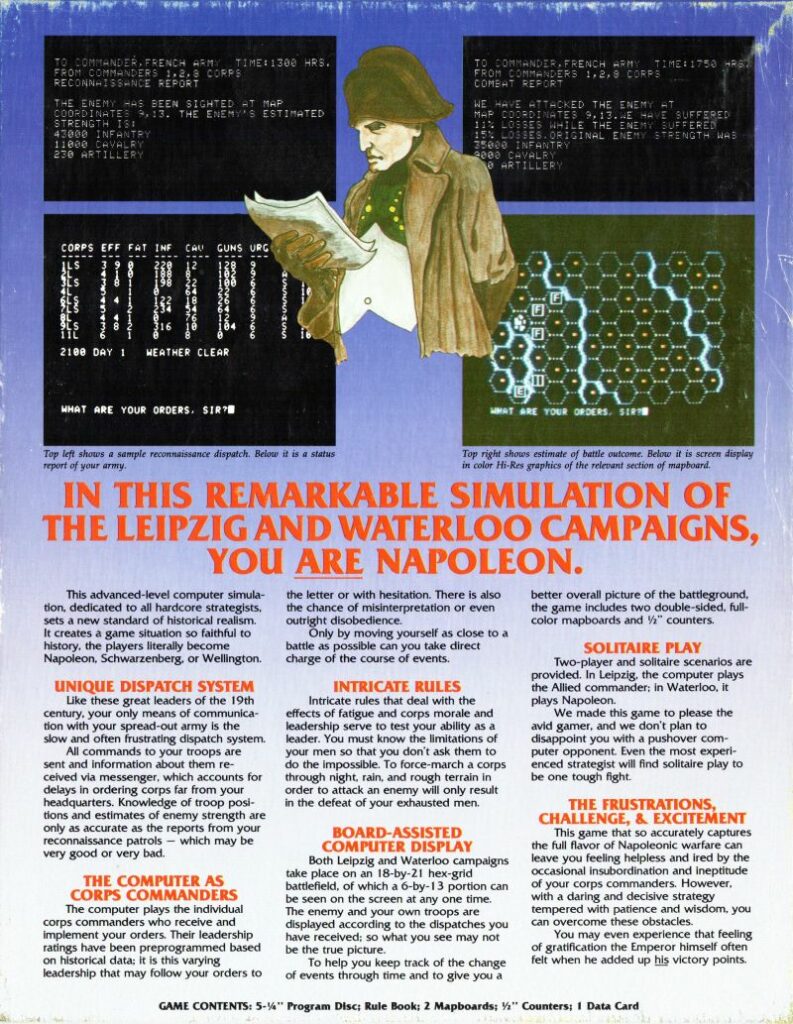
As always, the rating and review posts assume you have read the After Action Report
[Edit: 29/01/2025: In this article, I mention several times a critical scouting issue I had back in 2021. I finally found a way to avoid it and in 2025 retested the game as it was meant to play here. It did not significantly alter my opinion of it, so the article was not modified, except for a few notes and the fix of typos and similar style issues]
Napoleon’s Campaigns: 1813, 1815 by Paul Murray and SSI, USA
First release: December 1981 on Apple II
Tested on: Apple emulator
Total time tested: 6 hours
Average duration of a campaign: 2 hours
Complexity: Brutal (5/5)
Would recommend to a modern player: No
Would recommend to a designer: No
Final Rating: Totally obsolete
SSI’s Napoleon’s Campaigns is the second game credited to Paul Murray – after The Warp Factor. In late 1981, Paul Murray was the only programmer still employed by SSI: Ed Willinger had left immediately after Computer Ambush, and John Lyon had left shortly before or after the release of The Shattered Alliance – though he still programmed a handful of games. Paul Murray had joined SSI as early as 1980, but he still owed 6 months of his time to the Reserve Officers’ Training Corps. He joined the army in summer 1980, and during that time started working on The Warp Factor. Back in late 1980 or early 1981, he finished The Warp Factor in SSI and then worked on Napoleon’s Campaigns.
Napoleon’s Campaigns was another of SSI’s premium games, priced at $59.95. Indeed, the box does not skimp on content ;
- The manual,
- One reference card (one side includes the list of commands, the other the scenario parameters),
- Two folded plastic maps (each map is two-sided, one side for Waterloo, one side for Leipzig, so if you are playing with a friend each of you can use a map),
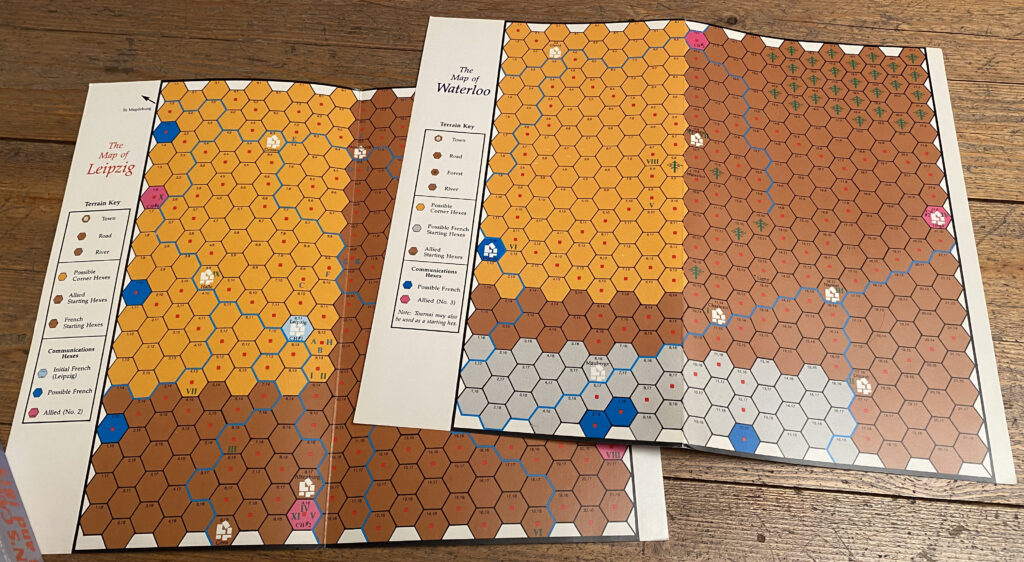
- A large number of two-sided counters, to use with the map
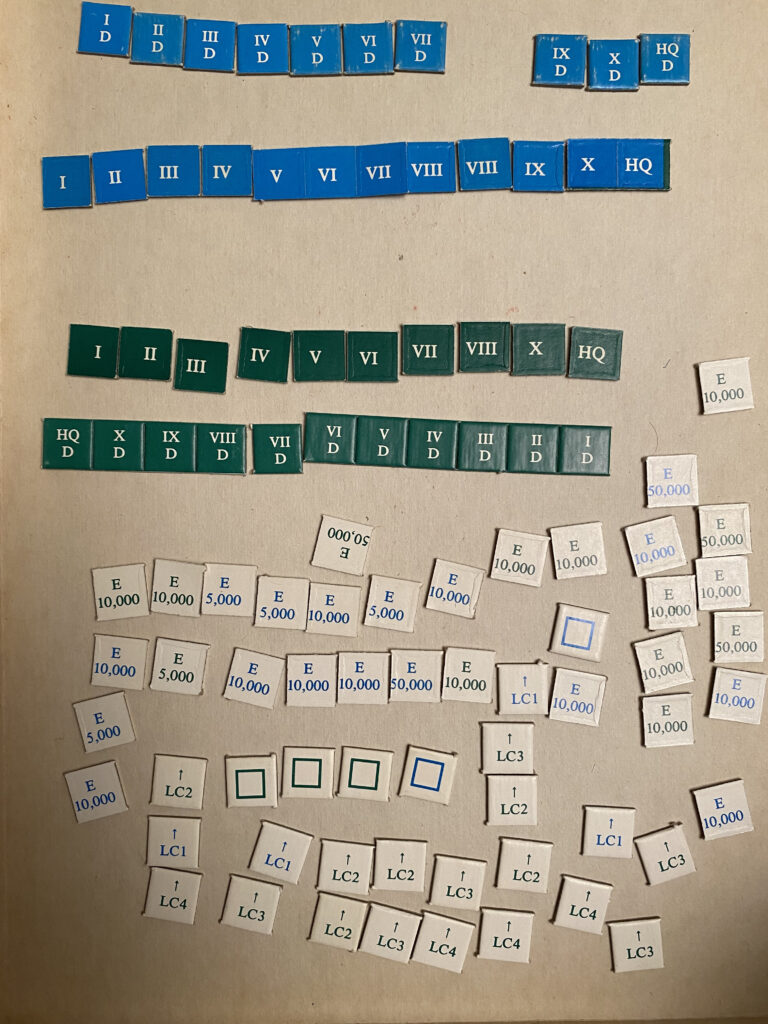
As with earlier SSI games, the map & counters are not needed to play the game, though given how lacklustre the map in the computer program is, they are comfortable to use. They are sadly low quality compared to the similar material offered in Avalon Hill games (eg Tanktics, Dnieper River Line).
There were two editions of the game: SSI Spring 1982 catalogue proposed a new version with a rare feature : “Now you can resolve all battles with or without using the computer. Simply use any methods you like (such as Napoleonic miniatures) and enter the offline combat results into the computer. It will incorporate them into the strategic game. If your current disk does not have this feature, send $5.00 to SSI with your old disk and we’ll ship you the new disk.” I don’t think it was a strong selling point, but it was available in the 1982 Road to Gettysburg, which used the same engine, so an easy addition. I suspect Joel Billings initially introduced the feature primarily for himself as he loved tabletop wargames.
I was very frustrated after my AAR for Napoleon’s Campaigns: there was the game I was supposed to play, and the game I played. Most importantly, the version I was supposed to play had a reconnaissance feature, instead of just random sighting of the enemy.
You can have a glimpse of what the game should have been in :
- The two screenshots from the back of the game box
- On the one on the top left, you can see a local commander reporting about enemy strength!
- On the one on the top-right, you can see a map where [E]nemy units are displayed, instead of only [F]riendly :
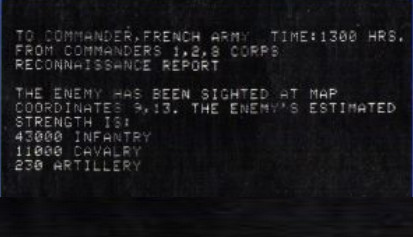
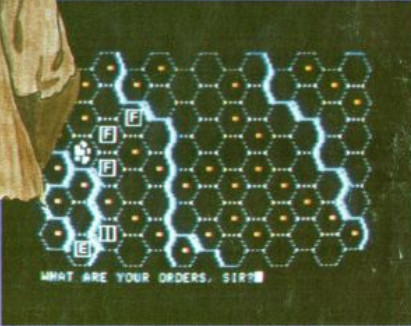
- The game box includes counters for “estimated enemy forces” (5 000, 10 000, 50 000), which you will never use [edit 29/01/2025: well, I did when I replayed it]
- The game includes a “patrol” order, allowing units with light cavalry to “have a reconnaissance radius of 2 hexes, and assume a normal march mode“. Using patrol never seemed to make any difference, light cavalry or not.
Early reviews for Napoleon’s Campaigns don’t report any issue, but a 1990 Computer Gaming World retrospective claims the game has “the foggiest fog of war this side of the English Channel“, which corresponds to my experience. It is possible that the Spring 1982 edition of the game, or some later batch, introduced those issues. It is also possible that the versions available on Internet all source to the same Apple II-to-Internet transfer that was faulty. I am currently looking for people in France that could transfer the diskette I have to an emulator, or at least test it on their own Apple II. I will report if anything comes in [edit 29/01/2025: As above, I found a fix for the issue, which was caused by emulating the wrong model of Apple II].
After the gaming fiasco that was my Leipzig campaign, I tried to give the game another chance with the battle of Waterloo, with the best AI the game had to offer. In the Waterloo campaign, the only side you can play in solitaire is the coalition, which must hold Brussels and Liege and suffers from poor coordination (the Anglo-Dutch cannot move for the first 2 turns, whereas the Germans start so far away from Wellington that it takes several turns for them to receive orders).
And so you get a bonus tiny AAR for which I will only show what the board looked like :
The Battle of Waterloo, a second-chance AAR.
- Part I : 14th of October, 1 PM
Wellington (#HQ) is in Brussels with his reserve (#VII). His Anglo Allied-Corps is deployed a few hours of march away, (#V and #VIII) except Hill’s 2nd Anglo-Corps (#VI), covering Tournai in the West. The Germans are occupying Charleroi (#I), Namur (#III) and Dinant (#II). Blücher is in Liege (#IV). The French can deploy in any of the grey or blue hexagons (including Tournai).
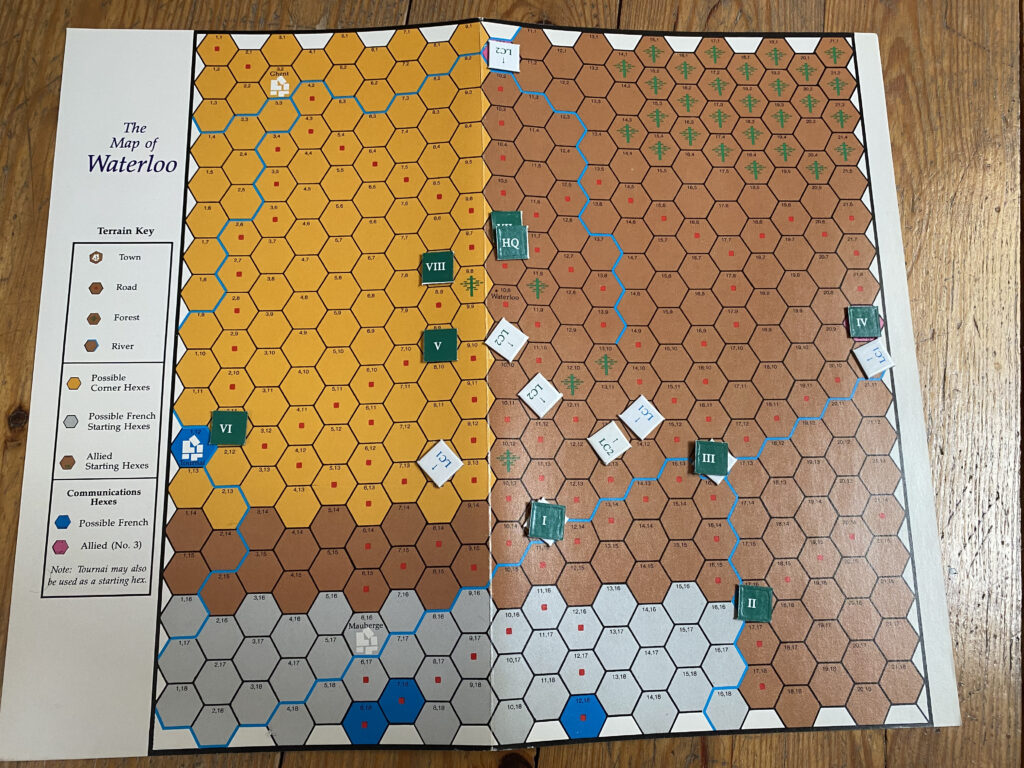
As the Germans are bracing for the inevitable French assault, Wellington gathers all his forces (except Hill’s 2nd Anglo-Allied corps, which will remain out of position for the duration of the campaign) and moves South to Charleroi.
- Part II : 15th of October, 1 PM
Before Wellington can reach Charleroi, some activity is detected between Tournai and Charleroi. Wellington takes his army in the general direction. Hill (#VI) senses French people all around him so he ignores Wellington’s increasingly whinier dispatches to join him and prepares to make a stand.
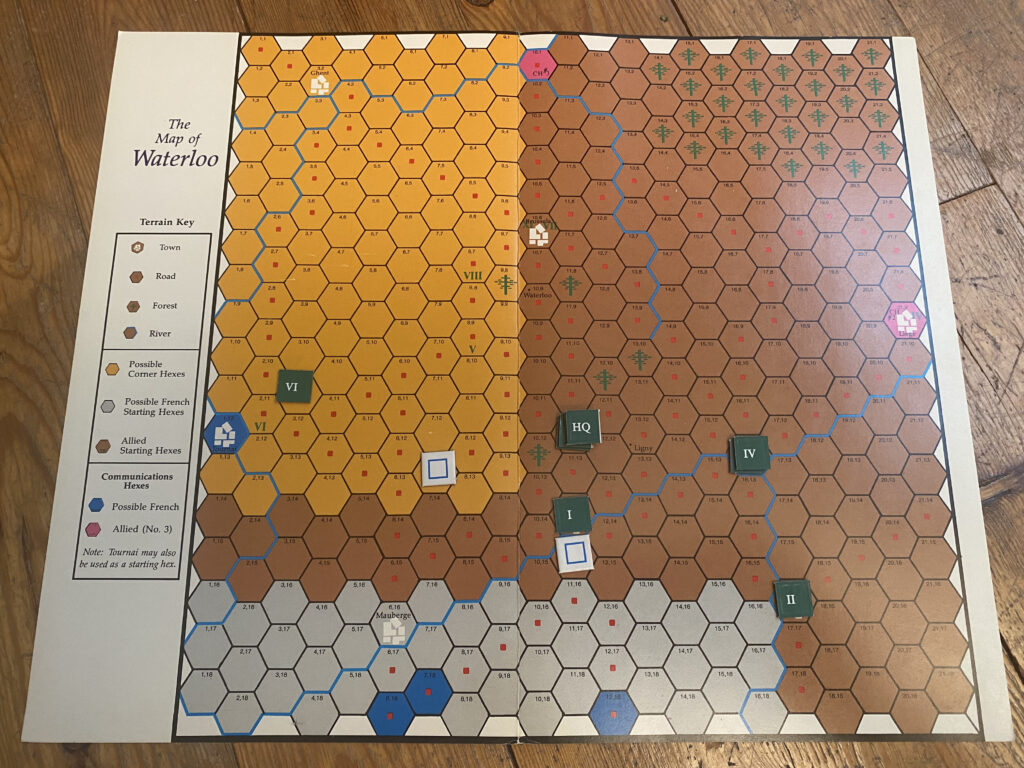
- Part III : 15th of October, 9 PM
As Wellington is moving East, enemy activity is spotted in the North, on a road that leads to Brussels. Wellington panics: will the French just snatch a defenceless Brussels? Wellington orders a force march back to Brussels!
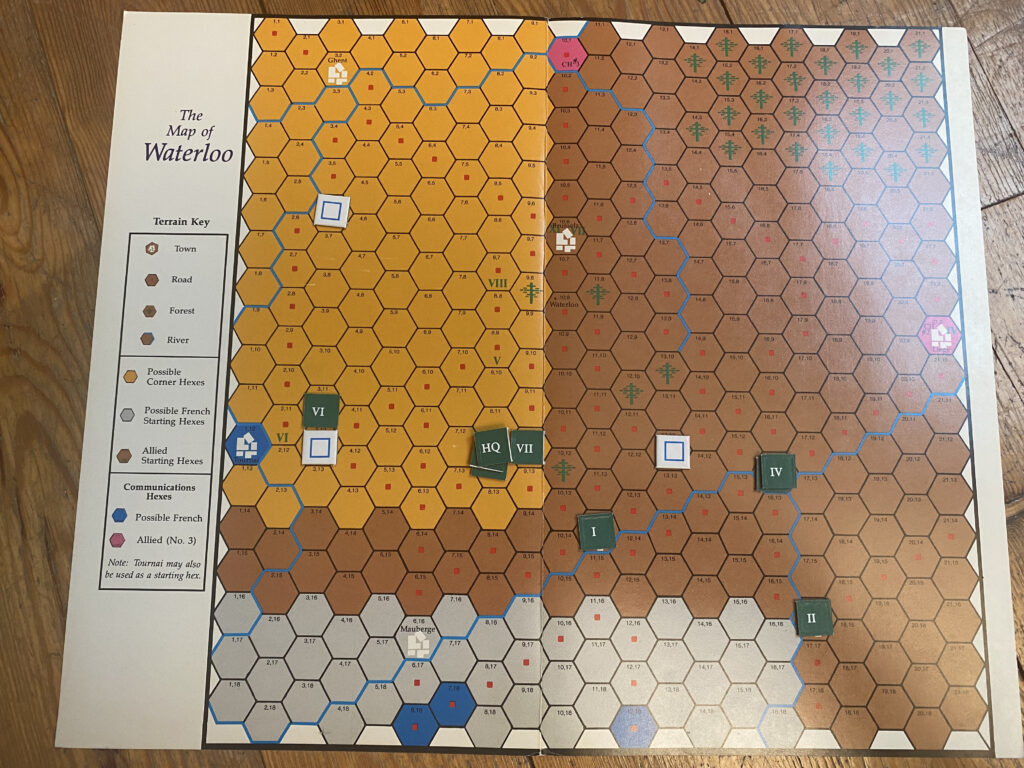
- Part IV : 17th of October, 5 AM
Wellington reaches Brussels and sits there with all his army, except Hill’s 2nd corps (still doing their own thing) and the Prince of Orange’s first Anglo-Allied Corps, which routed due to fatigue and rain, but without seeing any enemy. There is a French army outside of Brussels, but no attack.
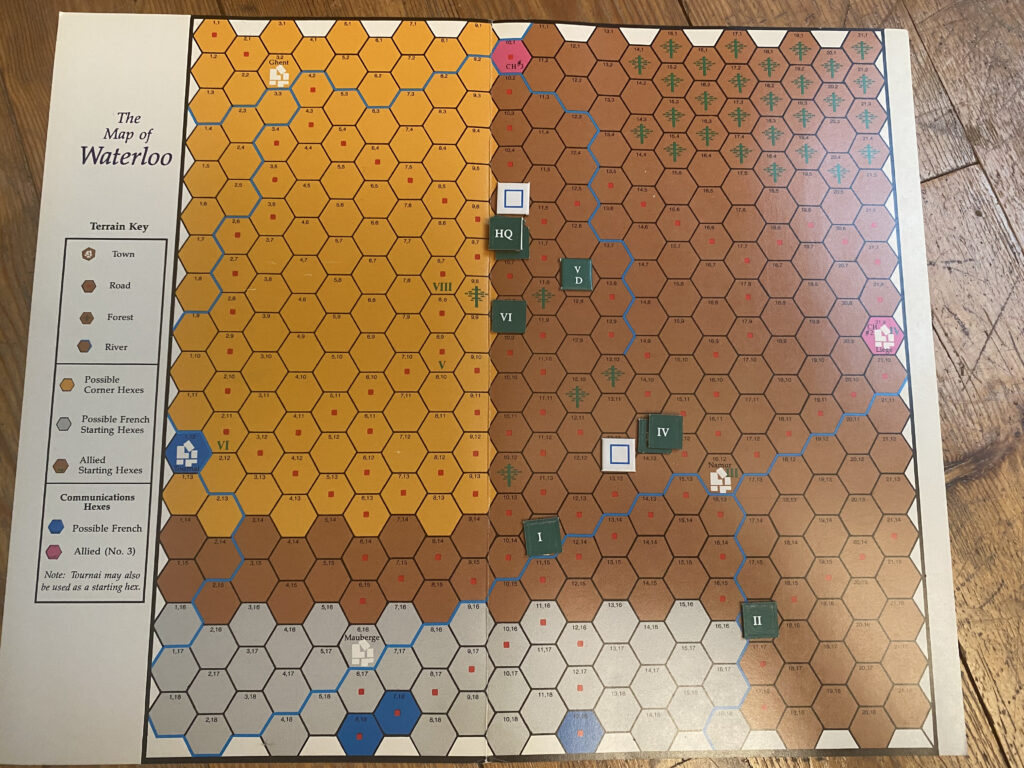
- Conclusion
No battle for the whole duration of the campaign, the only losses are desertions among the first Anglo-Allied Corps (#5), due to fatigue.
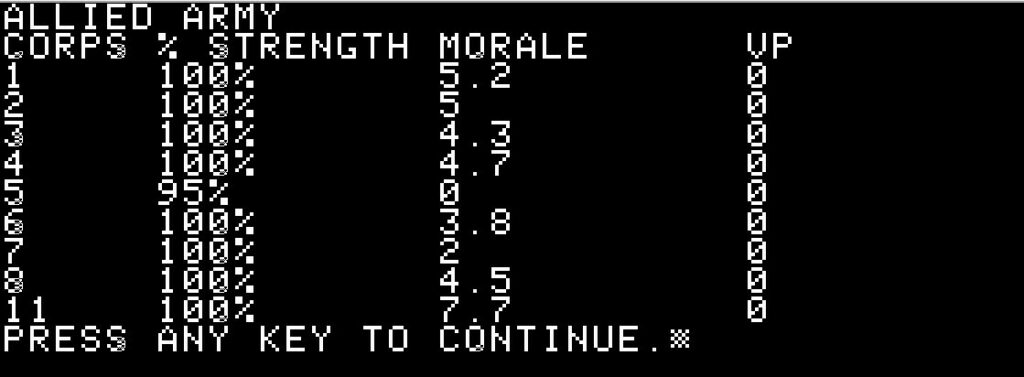
The French receive 10 victory points for occupying Ghent, and that’s all. They needed 11 for a draw and 30 for a marginal victory, so I won without firing a shot. I feel like I placated George McClellan, not defeated Napoleon.

And that was the hardest AI the game can offer. If I had not been blind, I am confident I would have performed even better.
In any case, let’s move to the rating.
A. Immersion
The game tries hard to be immersive with complex and somewhat asymmetric rules between the two warring sides (eg in the Leipzig scenario, the coalition player has to set up 3 different “communication lines”, one of each of the main nationality in the battle), with slow communication with distant units, with different “characters” for different generals, …
If the game didn’t have AI and reconnaissance issues, it would certainly work. In my version of the game, the best strategy is to create megastacks and avoid any engagement not involving said megastacks. To an extent, it feels like 15th-century Condottieri warfare: all manoeuvring, no combat. While it is true that I could not attack due to the reconnaissance bug, I don’t believe the AI has that excuse, and yet even mighty Napoleon never attacked me in 1815!

Rating: Very poor due to the scouting issue, presumably adequate if not quite good without it.
B. UI , Clarity of rules and outcomes
I think I made my point about reconnaissance. Let’s talk about the many other issues this game has.
First, this game has the worst manual I have ever read. The physical product is high quality and 20 pages long, but the content is impenetrable. Critical pieces of information are split into different chapters or missing altogether. There are exceptions and edge cases in every paragraph or so, some rules don’t seem to do anything in the game. In addition to the mysterious patrol mode, there is also apparently this concept of “secondary commander”, but the only thing the manual says about “secondary commanders” is how to change them. The game also allows you to change your “deployment mode” between “Road Mode” and “Deployed”, which is puzzling to me because the rest of the manual explains that the game applies the correct deployment mode automatically (ie if you are moving, you are in Road Mode).
The manual is so lacklustre that Joel Billings had to pen an article called Napoleon’s Campaigns 1813 & 1815: Some Notes in the March 1982 issue of Computer Gaming World. Officially those are designer and strategic notes, but Billings largely leverages the opportunity to clarify some important rules. In fact, I recommend reading the notes (three pages and a half) as a complement to the manual.
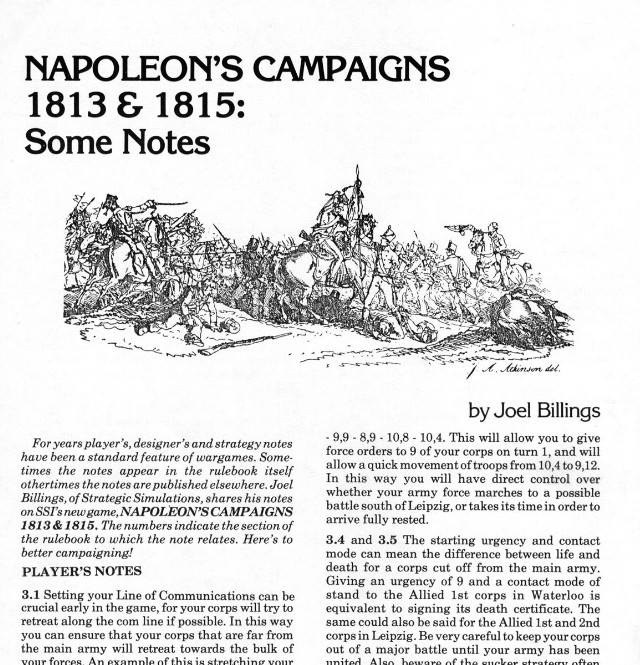
In his notes, Joel Billings states that “Movement is by far the most subtle element of the game, and the one that gives gamers the most problem.” It is true, but it should not have been and is only due to how poorly the game was designed in this regard.
You control movement only by giving your armies a starting point and a destination, and with that, your commanders will decide whether they walk casually, march or force-march depending on their urgency. A low urgency corps may decide not to move at all some turns, whereas an urgency 9 corps will almost always force-march.
- Having to give a starting point is the first peculiarity, and the reason is never explained in the manual. I had assumed it was to cover the case where your army was not where you expected it to be when it received your dispatch. According to Billings’s notes, the main purpose is that your army will force march to the starting point, and then decide what to do for the rest of the journey.
- Your troops will happily march until they panic and rout. Amusingly, routed corps execute an extra (retreat/withdrawal) movement, even if the cause of their rout is too much fatigue accumulated by their movement.
- Your troops ignore the time or weather when executing their orders, which means you cannot order a corps to move fast (high urgency) in daytime but not at night (which fatigues them three times faster). You have to manually stop them… except you cannot do it easily as you are dependent on dispatches that may take several turns to arrive,
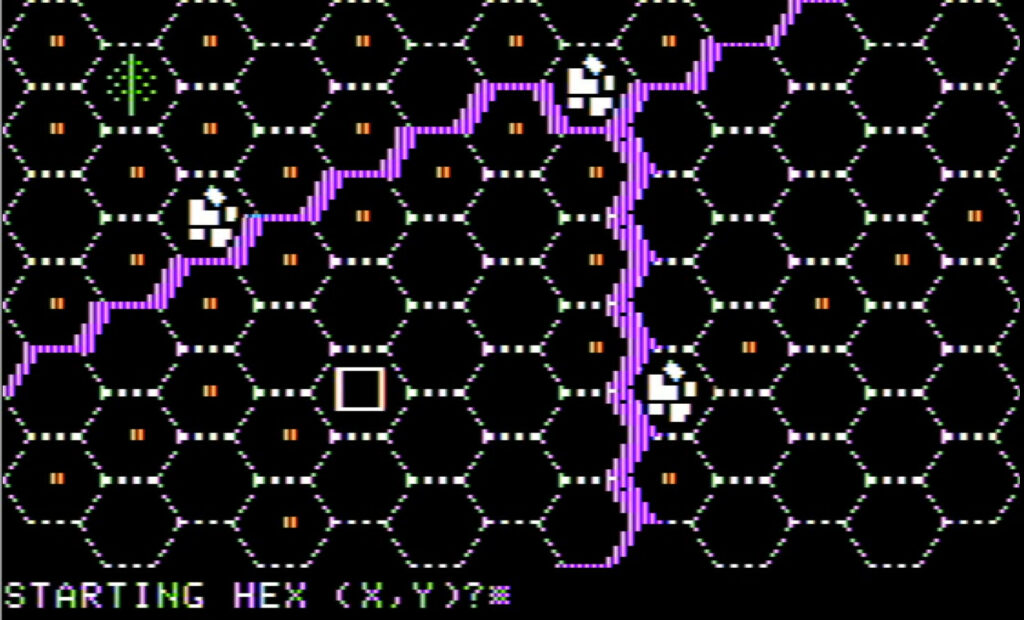
This is all the more frustrating since the game has a “move at specific speed” order, but you can only give it to the HQ Corps or to “Forces“.
Forces are ad hoc groupings of Corps that you order as one. It is practical, but it can only be given to units on their Lines of Communication and within range of the Commander-in-Chief. They have a few minor advantages, but all except ease of command should have been, design-wise, detached from “forces” and allocated to “being on a Line of Communication”. Paul Murray did not make that choice, so you are forced to do absurd things, like creating several “forces” with only one Corps each just to be able to give them “move at specific speed” orders. Meanwhile, a Corps one tile away from HQ but not on a road cannot “move at a specific speed“.
I could say a lot more about the UI, long story short every individual element is poorly thought-out and could have been streamlined without losing the “indirect control on your corps” aspect of the game – the game keeps hiding important information from you (stuff a commander-in-chief would know, like whether your enemy has been destroyed, whether your Line of Communication has been cut,…) while encouraging you to exploit the ruleset quirks for maximum performance.
Rating: Terrible, buggy reconnaissance or not.
C. Systems
I have shown or explained most of the systems in this game. There is still one feature I have to explain: battle resolution.
In a nutshell: it is needlessly complicated, especially for a game that claims to be about the bird’s eye view.
To cover it briefly, it uses a combat multiplier that depends on the weight of grenadiers, line infantry, light infantry, heavy cavalry, etc present in each corps. Since you don’t compose your own corps and losses are (almost) always proportional among the different unit types, giving a unique quality value to each of your corps would have been much easier, but noooo, you have to use this below, and compare it to the composition of your corps.
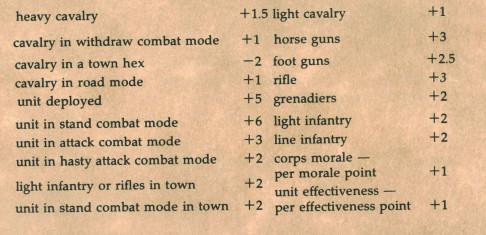
Once the game has your combat modifiers, it does some pretty iffy calculations based on commander aggressiveness, “adjusted urgency“, and whatever echelon attack you picked (the part where even the manual gave up on presenting hard numbers), and based on that it will determine computer losses.
Honestly, you don’t really care about this kind of detail, since you have no idea what the enemy is bringing to any individual engagement before the battle starts and since the final outcome of battles is fairly logical given the force involved. Still, it illustrates how the effort was not invested where needed in this game.
As for the rest, again, I rate the game I played, not the game the box and the manual describe.
Rating: Terrible. It could possibly be “quite good” without the reconnaissance issue. [Edit: 29/01/2025: No, it’s not]
D. Scenario design & Balancing
There are two scenarios in the game. They seem to allow many different approaches, but of course like everything else it was ruined for me by the reconnaissance issue, but also by very passive AI.
Rating: Bad
E. Did I make interesting decisions ?
No. I have not been given the tools to make interesting decisions.
F. Final rating
Totally obsolete for the version I played. It is the first or second game to work with incomplete/delayed information, but as a game it is a failure.
But, with what I have seen, I am expecting a lot from Road to Gettysburg in early 1982. It uses the same engine, and I have strong hopes it does not have the issues I encountered in Napoleon’s Campaigns.
Contemporary Reviews
Napoleon’s Campaigns received its first review in January 1982 in Computer Gaming World – a review preceded by a 5-page AAR by Joel Billings himself – and let me tell you that Billings did not face any of the issues I had.

In his review of Napoleon’s Campaigns, Daniel Weitz claims he has never played a similar game handling corps-level simulation and limited intelligence in his 20 years of wargaming. Despite this introduction, I find the review fairly neutral, except for the conclusion: “The game is a must for anyone interested in the problems of army-level command or Napoleonic simulations.” Weitz also wished he could simulate the individual battle with 15 mm miniatures, and then input the result, a wish suspiciously close to what SSI delivered just a few months later.
In the February 1982 issue of Softtalk, Archibald Dale gives a long review of the game, which he describes as “highly complicated”. Unlike Weitz, Dale appreciated the map provided in the game box and used it, and says the game is “such a realistic interpretation that any serious wargamer will be entranced”. Dale seems to not have encountered my issues: the review includes a screenshot showing enemy forces, and he specifically states that reconnaissance reports include enemy strength. A pragmatist, Archibald Dale reviewed the game (along with The Road to Gettysburg) a second time for Creative Computing, in August 1982 – the review is essentially the same.
The game had some impact in France. A June 1986 issue of Jeux & Stratégie has two pages on Napoleon’s Campaigns: 1813 & 1815, as part of an article on the three new wargames of “astonishing realism” (the two others are Southern Command and the Shattered Alliance, but they share only one page together). Tilt (March 1984) is less enthusiastic, giving the game 3 stars out of 6 in a retrospective.
The game gradually received fewer reviews after that, until the October 1990 ComputerGaming World retrospective on wargames. Napoleon’s Campaigns received 2.5/5 stars: “Its obsolescence is clearly visible”. The game survived in SSI’s catalogues until Summer 1986 ; I hope it was replaced with other operational games with a strong emphasis on command and control, but I won’t know before some time.
4 Comments
I see you’re uploading the manuals to archive.org, that’s cool.
Indeed, I do this for manuals I could not find anywhere and where either sent to me by someone nice, or that I acquired myself
Two problems: Dunning-Krueger syndrome and developer overreach.
The first: the developer knows how the game works, thus he doesn’t really need to explain it. It’s obvious. He can speak in a kind of shorthand and everyone will understand what he means, because he knows what he means.
The second: bit off more than he could chew. He just wanted so bad to make this game that was in his head, and the computer couldn’t do it. The box and manual were printed before the game was completed. So he just amputated parts of the game that wouldn’t fit and didn’t say anything about it. People would understand.
Oh, and as usual, lack of playtesting. A problem that badly affected wargames of the era. Try to find a single one without game-breaking problems or pages of errata generated by unpaid playtesters: aka customers.
I don’t think it is Dunning-Krueger, but it definitely looks like a developer not realizing how complex his game is. And definitely, a case of “biting off more than he could chew” – and possibly more than an Apple II could chew, too. Printing the manual before the game was finished seems typical of SSI as well, given the number of erratas in Torpedo Fire and in Shattered Alliance (in which a complete table was replaced by an errata in a menu of the game – very practical to check on the fly).
Joel Billings told me that the QA in the early days of SSI had only one person : Joel Billings himself. And in addition to lack of manpower, “QA” is also a process and a way to work, and the industry as a whole did not have that in 1980.
Comments are closed, but trackbacks and pingbacks are open.